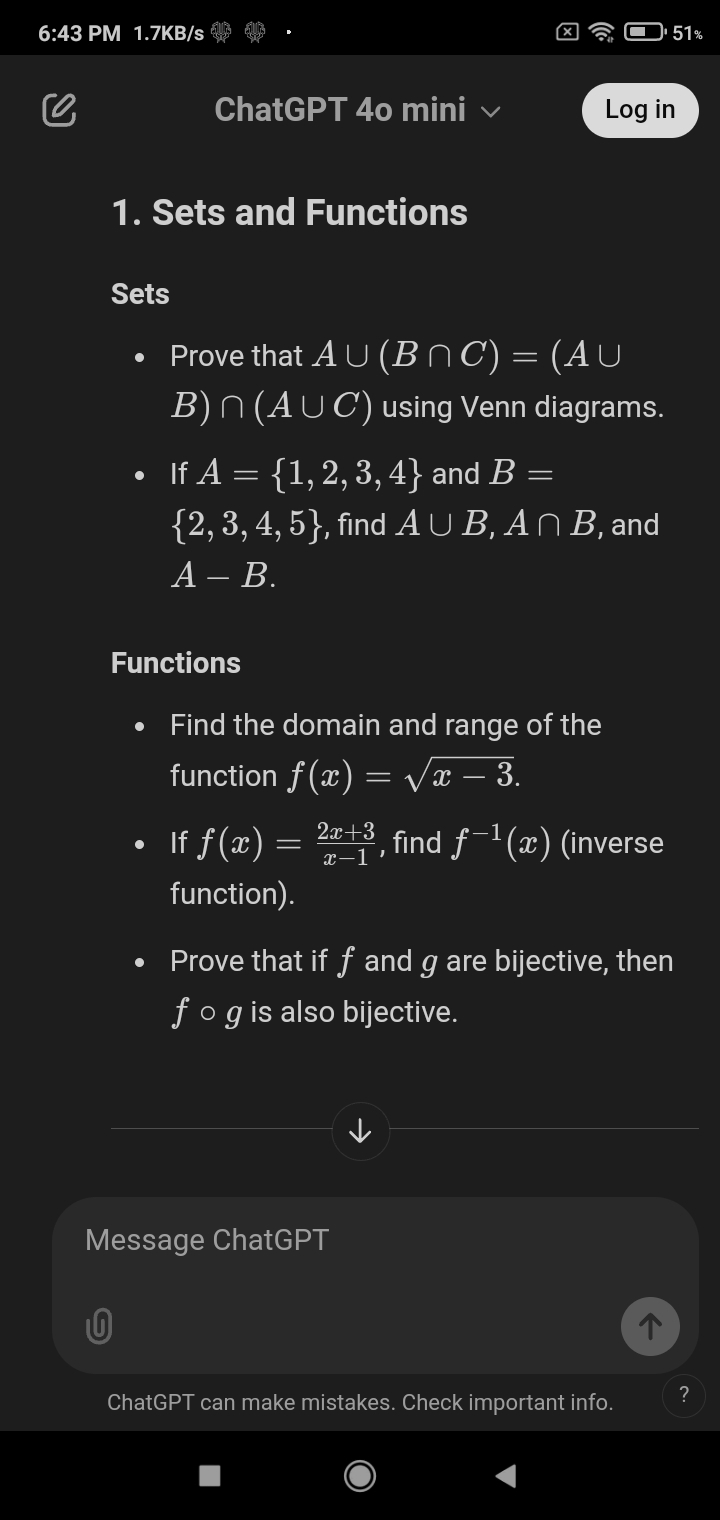Prove that A ∪ (B ∩ C) = (A ∪ B) ∩ (A ∪ C) using Venn diagrams. If A = {1, 2, 3, 4} and B = {2, 3, 4, 5}, find A ∪ B, A ∩ B, and A - B. Find the domain and range of the function f(... Prove that A ∪ (B ∩ C) = (A ∪ B) ∩ (A ∪ C) using Venn diagrams. If A = {1, 2, 3, 4} and B = {2, 3, 4, 5}, find A ∪ B, A ∩ B, and A - B. Find the domain and range of the function f(x) = √(x - 3). If f(x) = (2x + 3) / (x - 1), find f^(-1)(x). Prove that if f and g are bijective, then f ∘ g is also bijective.

Understand the Problem
The question is asking for several mathematical proofs and calculations related to set theory and functions, specifically proving the equality of two sets using Venn diagrams, performing operations on specific sets, finding the domain and range of a function, calculating an inverse function, and proving a property of bijective functions.
Answer
1. $A \cup (B \cap C) = (A \cup B) \cap (A \cup C)$ 2. $A \cup B = \{1, 2, 3, 4, 5\}$ 3. $A \cap B = \{2, 3, 4\}$ 4. $A - B = \{1\}$ 5. Domain: $[3, ∞)$; Range: $[0, ∞)$ 6. $f^{-1}(x) = \frac{x + 3}{x - 2}$ 7. $f \circ g$ is bijective.
Answer for screen readers
- Proved: $A \cup (B \cap C) = (A \cup B) \cap (A \cup C)$.
- $A \cup B = {1, 2, 3, 4, 5}$
- $A \cap B = {2, 3, 4}$
- $A - B = {1}$
- Domain of $f(x) = \sqrt{x - 3}$ is $[3, ∞)$, Range is $[0, ∞)$.
- Inverse $f^{-1}(x) = \frac{x + 3}{x - 2}$.
- $f \circ g$ is bijective if both $f$ and $g$ are bijective.
Steps to Solve
- Proving the Set Equality Using Venn Diagrams
To prove $A ∪ (B ∩ C) = (A ∪ B) ∩ (A ∪ C)$ using Venn diagrams, we can visualize each side:
- Left Side: $A ∪ (B ∩ C)$ includes all elements in $A$ and elements that are both in $B$ and $C$.
- Right Side: $(A ∪ B) ∩ (A ∪ C)$ includes elements in either $A$ or $B$, and simultaneously in either $A$ or $C$.
By overlapping parts of the circles representing each set, we can see that both sides end up covering the same areas, thus proving the equality.
- Finding Set Operations
Given:
- $A = {1, 2, 3, 4}$
- $B = {2, 3, 4, 5}$
Now, calculate:
-
Union: $A ∪ B = {1, 2, 3, 4, 5}$
-
Intersection: $A ∩ B = {2, 3, 4}$
-
Difference: $A - B = {1}$
- Finding Domain and Range of the Function
For the function $f(x) = \sqrt{x - 3}$:
-
Domain: Set the expression inside the square root to be non-negative:
$$x - 3 ≥ 0 \Rightarrow x ≥ 3$$
Thus, the domain is $[3, ∞)$.
-
Range: For $y = f(x)$, the smallest value that $f(x)$ can take is $0$ (when $x = 3$), so the range is $[0, ∞)$.
- Finding the Inverse Function
For $f(x) = \frac{2x + 3}{x - 1}$:
-
Start by replacing $f(x)$ with $y$:
$$y = \frac{2x + 3}{x - 1}$$
-
Swap $x$ and $y$ and solve for $y$:
$$x = \frac{2y + 3}{y - 1}$$
Multiply both sides by $(y - 1)$:
$$x(y - 1) = 2y + 3$$
Rearranging gives:
$$xy - x = 2y + 3$$
$$xy - 2y = x + 3$$
Factor out $y$:
$$y(x - 2) = x + 3$$
$$y = \frac{x + 3}{x - 2}$$
Thus, the inverse function is $f^{-1}(x) = \frac{x + 3}{x - 2}$.
- Proving Composition of Bijective Functions
To prove that if $f$ and $g$ are bijective, then $f ∘ g$ is also bijective:
- Both $f$ and $g$ have a one-to-one correspondence (bijective).
- Thus, for every $x$ in the domain of $g$, there exists a unique $y$ in the range of $g$, and for each corresponding $y$, there’s a unique $z$ in the range of $f$.
- Therefore, $f ∘ g$ is also one-to-one, and every element in the target set has a unique pre-image from the domain, confirming that $f ∘ g$ is bijective.
- Proved: $A \cup (B \cap C) = (A \cup B) \cap (A \cup C)$.
- $A \cup B = {1, 2, 3, 4, 5}$
- $A \cap B = {2, 3, 4}$
- $A - B = {1}$
- Domain of $f(x) = \sqrt{x - 3}$ is $[3, ∞)$, Range is $[0, ∞)$.
- Inverse $f^{-1}(x) = \frac{x + 3}{x - 2}$.
- $f \circ g$ is bijective if both $f$ and $g$ are bijective.
More Information
This proof illustrates cleverly how different set operations lead to the same resulting set. The function calculations demonstrate clarity regarding domains and ranges, illustrating foundational concepts in algebra and set theory. The bijection property is crucial in understanding function compositions in calculus.
Tips
- Confusing union and intersection in step definitions. Always double-check the operations being performed.
- Misinterpreting the domain of the square root function. Remember to set the inside of the square root to be non-negative.
- Forgetting to swap variables when finding the inverse function.
AI-generated content may contain errors. Please verify critical information